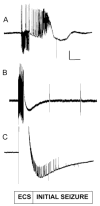Seizure and epilepsy: studies of seizure disorders in Drosophila
- PMID: 21906534
- PMCID: PMC3532860
- DOI: 10.1016/B978-0-12-387003-2.00001-X
Seizure and epilepsy: studies of seizure disorders in Drosophila
Abstract
Despite the frequency of seizure disorders in the human population, the genetic and physiological basis for these defects has been difficult to resolve. Although many genetic contributions to seizure susceptibility have been identified, these involve disparate biological processes, many of which are not neural specific. The large number and heterogeneous nature of the genes involved makes it difficult to understand the complex factors underlying the etiology of seizure disorders. Examining the effect known genetic mutations have on seizure susceptibility is one approach that may prove fruitful. This approach may be helpful in both understanding how different physiological processes affect seizure susceptibility and identifying novel therapeutic treatments. We review here factors contributing to seizure susceptibility in Drosophila, a genetically tractable system that provides a model for human seizure disorders. Seizure-like neuronal activities and behaviors in the fruit fly are described, as well as a set of mutations that exhibit features resembling some human epilepsies and render the fly sensitive to seizures. Especially interesting are descriptions of a novel class of mutations that are second-site mutations that act as seizure suppressors. These mutations revert epilepsy phenotypes back to the wild-type range of seizure susceptibility. The genes responsible for seizure suppression are cloned with the goal of identifying targets for lead compounds that may be developed into new antiepileptic drugs.
Copyright © 2011 Elsevier Inc. All rights reserved.
Figures



References
-
- Boege F, Straub T, Kehr A, Boesenberg C, Christiansen K, Anderson A, Jacob F, Kohrle J. Selected novel flavones inhibit the DNA binding or the DNA religation step of eukaryotic topoisomerase I. J Biol Chem. 1996;271:2262–2270. - PubMed
-
- Carlen PL, Frances S, Zhang L, Naus C, Kushnir M, Velazquez JL. The role of gap junctions in seizures. Brain Res Rev. 2000;32:235–241. - PubMed
Publication types
MeSH terms
Substances
Grants and funding
LinkOut - more resources
Full Text Sources
Medical
Molecular Biology Databases

